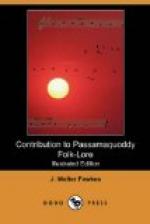I spent several days at Calais, while collecting traditions with the phonograph, and also visited Pleasant Point, where I made the acquaintance of some of the most prominent Indians, including the governor. Most of them speak English very well, and are ready to grant their assistance in preserving their old stories and customs. The younger members of the tribe are able to read and write, and are acquainted with the ordinary branches of knowledge as taught in our common schools. I should judge from my own observations that the language is rapidly dying out. The white women who have married into the tribe have generally acquired the language more or less perfectly. In their intercourse with each other, Indians make use of their own language.
In taking these records with the phonograph I had an interesting experience. The first time I met Noel Josephs, I greeted him after the Zuni fashion. I raised my hand to his mouth, and inhaled from it. He followed in identically the same manner in which a Zuni Indian would respond. I asked him what it meant. He said that it was a way of showing friendship. He remembered that, when he was a boy, a similar mode of greeting was common among Indians.[3] Mrs. Brown recalled having seen a similar ceremony after she was received into the tribe. The meaning of this similarity I leave to others to conjecture. In a legend mentioned by Mrs. Brown concerning a game of “All-tes-teg-enuk,” played by a youth against an old man, the latter, who has magic power, has several times regained his youth by inhaling the breath of his young opponent.[4]
[Footnote 3: My surprise at this coincidence was very great, but I confess that I was also interested to hear from the lips of my Indian friend, at parting, the familiar Italian word, “Addio.”]
[Footnote 4: Some Indoor and Outdoor Games of the Wabanaki Indians, Trans. Roy. Soc. Canada, Section II. 1889.]
THE SNAKE DANCE.
The Passamaquoddies, no doubt, in old times, had many dances, sacred and secular. Some of these were very different from what they now are, and in consequence it is not easy to recognize their meaning. Indians declare that in their youth dances were much more common. Possibly some of these will never be danced again. That the Micmacs, neighbors of the Passamaquoddies, had dances in which elaborate masks were worn, seems to be indicated by pictographs found on the rocks in Nova Scotia. Mrs. Brown has in her possession a head-band made of silver, similar to those worn in ancient times on festive occasions, and probably at dances. It was not necessarily a badge of a chief. In excavations made at East Machias, an Indian was found with a copper head-band and the remnant of a woven tiara. These relics are now in the hands of Dr. Shehan, of Edmunds, Maine. Copper head-bands have repeatedly been found on the skulls of Mound Indians. When a boy, I myself was present at the work of excavating an Indian burial place on the banks of Charles River, near the end of Maple Street, Watertown. With one of these skeletons a turtle shell was found, which was possibly an old Indian rattle.




